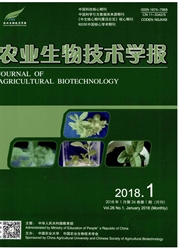

 中文摘要:
中文摘要:
WRKY是植物中特有的锌指型转录因子,其广泛参与植物对生物及非生物胁迫的响应过程。本研究从小麦(Triticum aestivumL.)中分离出一个新的WRKY转录因子基因TaWRKY51,其全长cDNA序列长度为1295bp,其中开放阅读框(ORF)为942bp,编码一个由313个氨基酸组成的多肽。用半定量RT-PCR进行表达谱分析,结果显示,TaWRKY51基因在分蘖节、叶和根系中的表达水平较高,并且受干旱胁迫诱导上调表达。在拟南芥(Arabidopsisthaliana)中过量表达TaWRKY51基因导致转基因株系侧根数目明显增多,并且对ABA、干旱和盐等胁迫处理的敏感性增加,表明该基因可能在植物响应非生物逆境胁迫信号传导过程中起负调控作用。本研究有助于揭示TaWRKY51基因调控植物侧根发育及响应非生物逆境胁迫的分子机制。
 英文摘要:
英文摘要:
Transcription factors V/RKY are plant specific genes and participate in response to various biotic and abiotic stress. To investigate the role of the WRKY gene in wheat and explore their role in the respons to abiotic stress, in this study, a new wheat(Triticum aestivum L.) WRKY transcription factor, designated as TaIVRKY51 was cloned by using RT-PCR, combined with RACE method. The full-length cDNA of TaWRKY51 was of 1 295 bp with a 942 bp of open read frame(ORF) encoding a protein of 313 amino acid residues. Length of 3'UTR and 5'UTR were 73 and 280 bp, respectively. Sequence and structure analysis indicated that TaIVRKY51 possessed one WRKY domain and one C2H2 type Zinc-finger domain. BLAST analysis revealed that TaWRKY51 was most homologous to OsWRKY51 from rice(Oryza sativa)(66%), and AtWRKYll, AtWRKY17 from Arabidopsis thaliana(57% ). Phylogenetic analysis revealed that all WRKY domain containing proteins could be grouped into three classes and TaWRKYS1 belonged to the Class 11 because TaWRKYS1 contained one WRKY domain and one C2H2 type Zinc-finger domain. Semi-quantitative RT-PCR analysis exhibited that the mRNA abundance of TaWRKYS1 was relatively higher in leaves, root and inter-node, as compared to in seeds of 12 d after pollination. The expression level of TaWRKYM gene was also higher in mature leaves and aged leaves than in young leaves. The results indicated that TaWRKYS1 could be a positive regulator in leaves maturing and aging. And expression level of TaWRKYS1 gene was upregulated after drought treatment which suggested that TaWRKYS1 might be involved in abiotic stress response. Moreover, ecotopic overexpression of TaWRKYM in A. thaliana significantly increased the number of lateral root, suggesting TaWRKYS1 might participate in lateral root regulation in A. thaliana. Remarkably, transgenic lines grown on MS medium containing ABA, mennitol and NaCI were much more sensitive to ABA, drought and salt stress as compared to WT, and transgenic lines grown on soil could not surviv
 同期刊论文项目
同期刊论文项目
 同项目期刊论文
同项目期刊论文
 Wheat (Triticum aestivum L.) root proteome and differentially expressed root proteins between hybrid
Wheat (Triticum aestivum L.) root proteome and differentially expressed root proteins between hybrid Molecular mapping of QTLs for root response to phosphorus deficiency at seedling stage in wheat (Tri
Molecular mapping of QTLs for root response to phosphorus deficiency at seedling stage in wheat (Tri Cloning and expression profiles of 15 genes encoding WRKY transcription factor in wheat (Triticum ae
Cloning and expression profiles of 15 genes encoding WRKY transcription factor in wheat (Triticum ae Identification of differentially expressed proteins between hybrid and parents in wheat (Triticum ae
Identification of differentially expressed proteins between hybrid and parents in wheat (Triticum ae The relationship of differential expression of genes in GA biosynthesis and response pathways with h
The relationship of differential expression of genes in GA biosynthesis and response pathways with h A novel histidine kinase gene, ZmHK9, mediate drought tolerance through the regulation of stomatal d
A novel histidine kinase gene, ZmHK9, mediate drought tolerance through the regulation of stomatal d Comparative Proteomic Analysis of Embryos between a Maize Hybrid and Its Parental Lines during Early
Comparative Proteomic Analysis of Embryos between a Maize Hybrid and Its Parental Lines during Early Expression and functional analysis of genes encoding cytokinin receptor-like histidine kinase in mai
Expression and functional analysis of genes encoding cytokinin receptor-like histidine kinase in mai Expression divergence of TaMBD2 homoeologous genes encoding methyl CpG-binding domain proteins in wh
Expression divergence of TaMBD2 homoeologous genes encoding methyl CpG-binding domain proteins in wh Epigenetic modification contributes to the expression divergence of three TaEXPA1 homoeologs in hexa
Epigenetic modification contributes to the expression divergence of three TaEXPA1 homoeologs in hexa Relationship of Photosynthetic Carbon Assimilation Related Traits of Flag Leaves with Yield Heterosi
Relationship of Photosynthetic Carbon Assimilation Related Traits of Flag Leaves with Yield Heterosi Overexpression of a wheat stearoyl-ACP desaturase (SACPD) gene TaSSI2 in Arabidopsis ssi2 mutant com
Overexpression of a wheat stearoyl-ACP desaturase (SACPD) gene TaSSI2 in Arabidopsis ssi2 mutant com Maize (Zea mays L.) seedling leaf nuclear proteome and differentially expressed proteins between a h
Maize (Zea mays L.) seedling leaf nuclear proteome and differentially expressed proteins between a h 期刊信息
期刊信息
